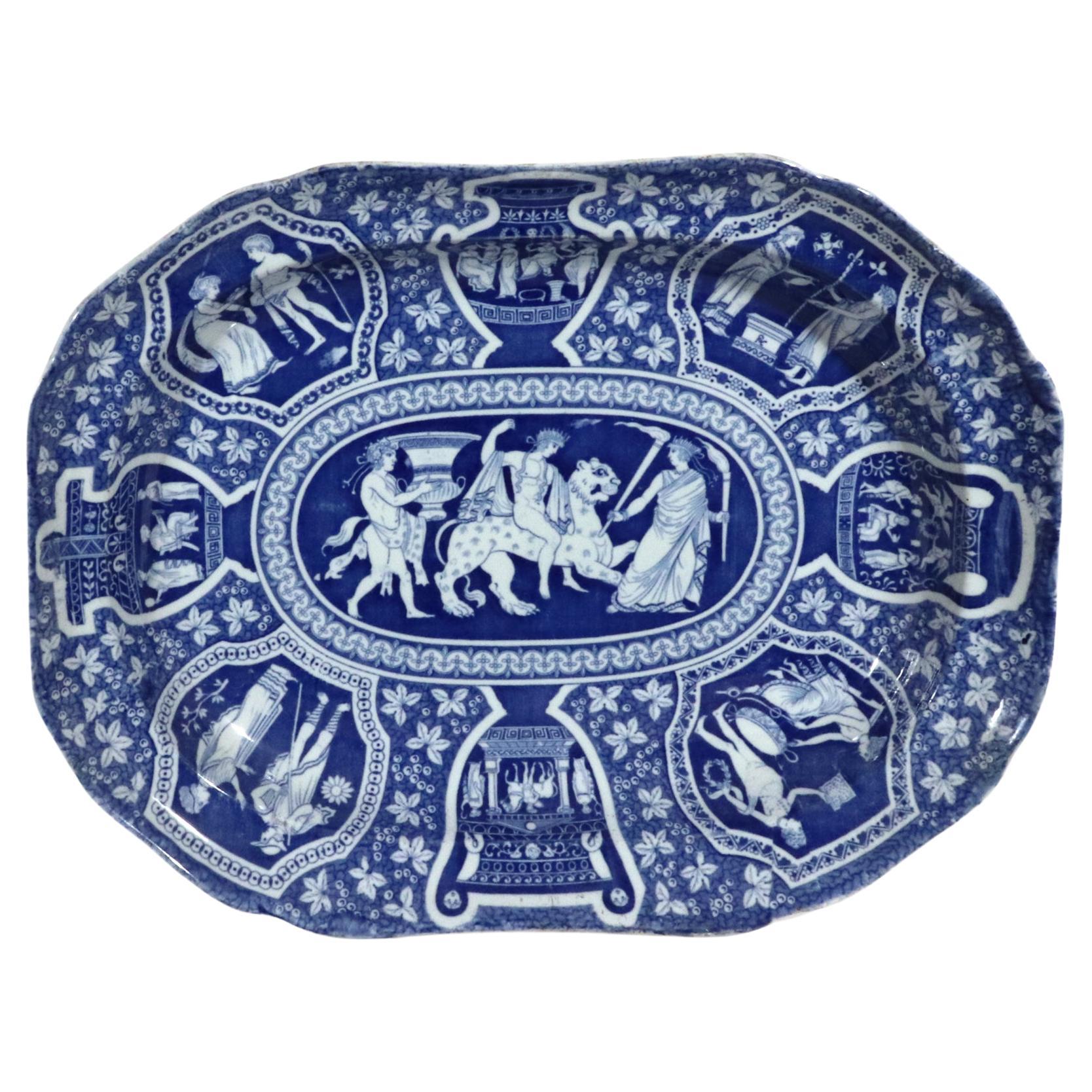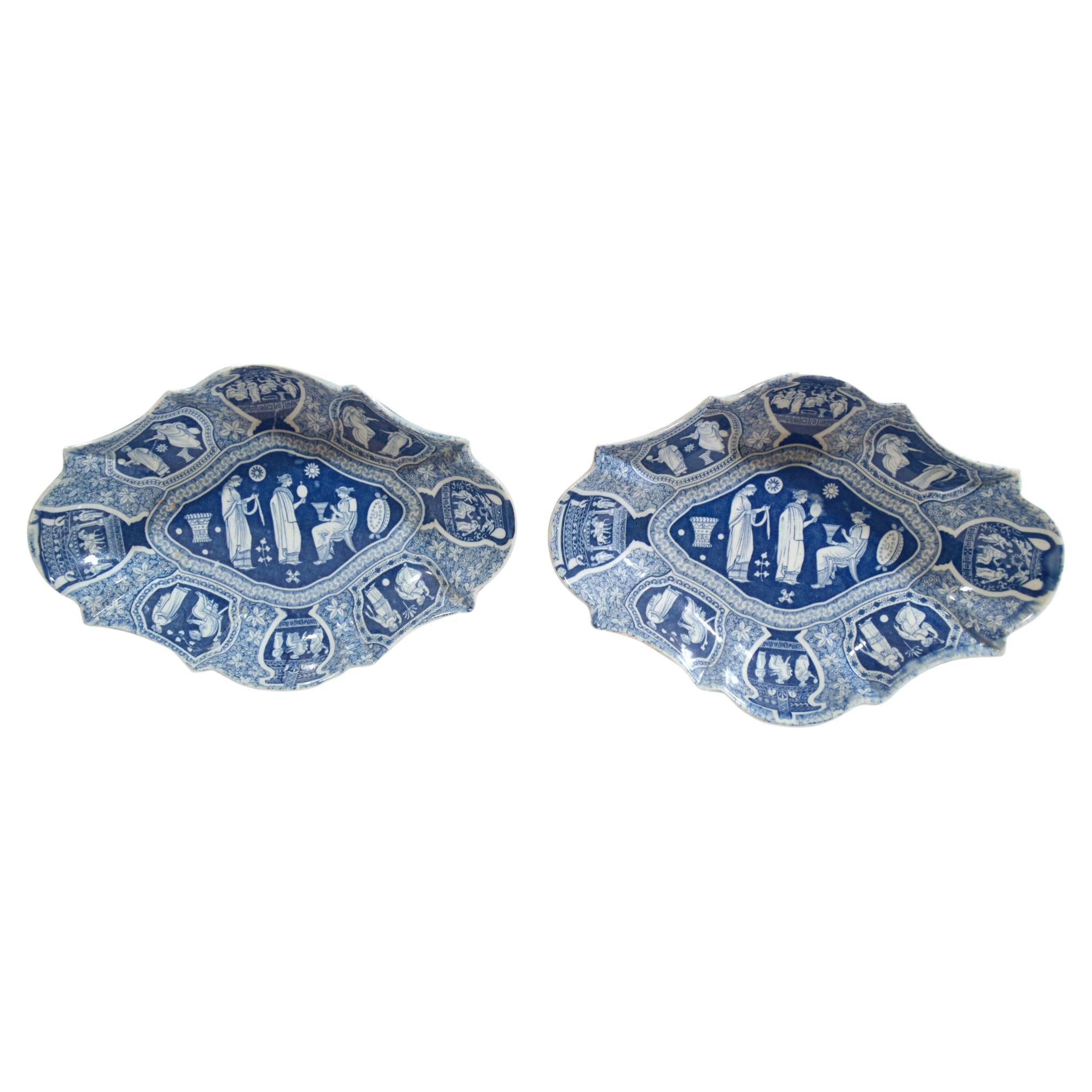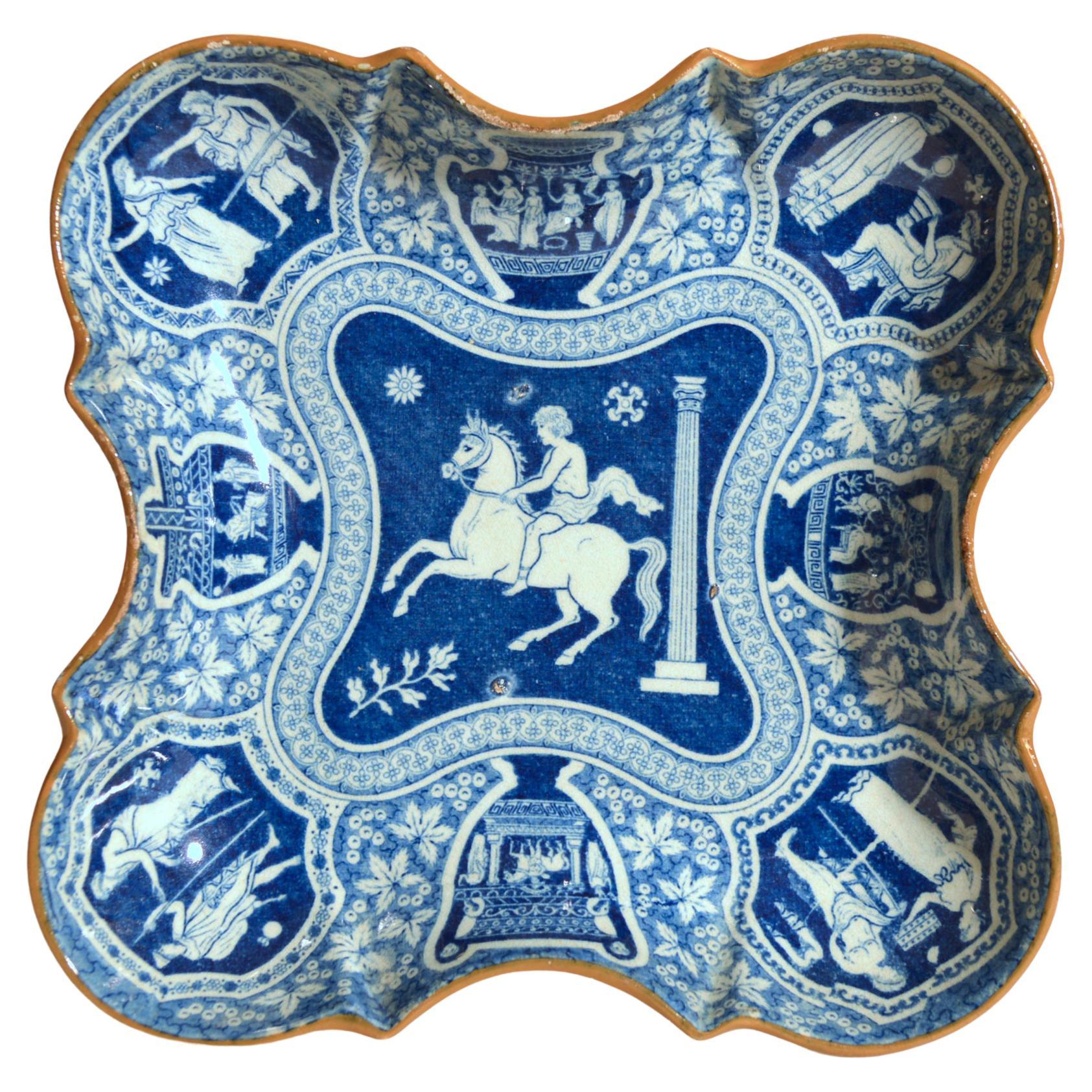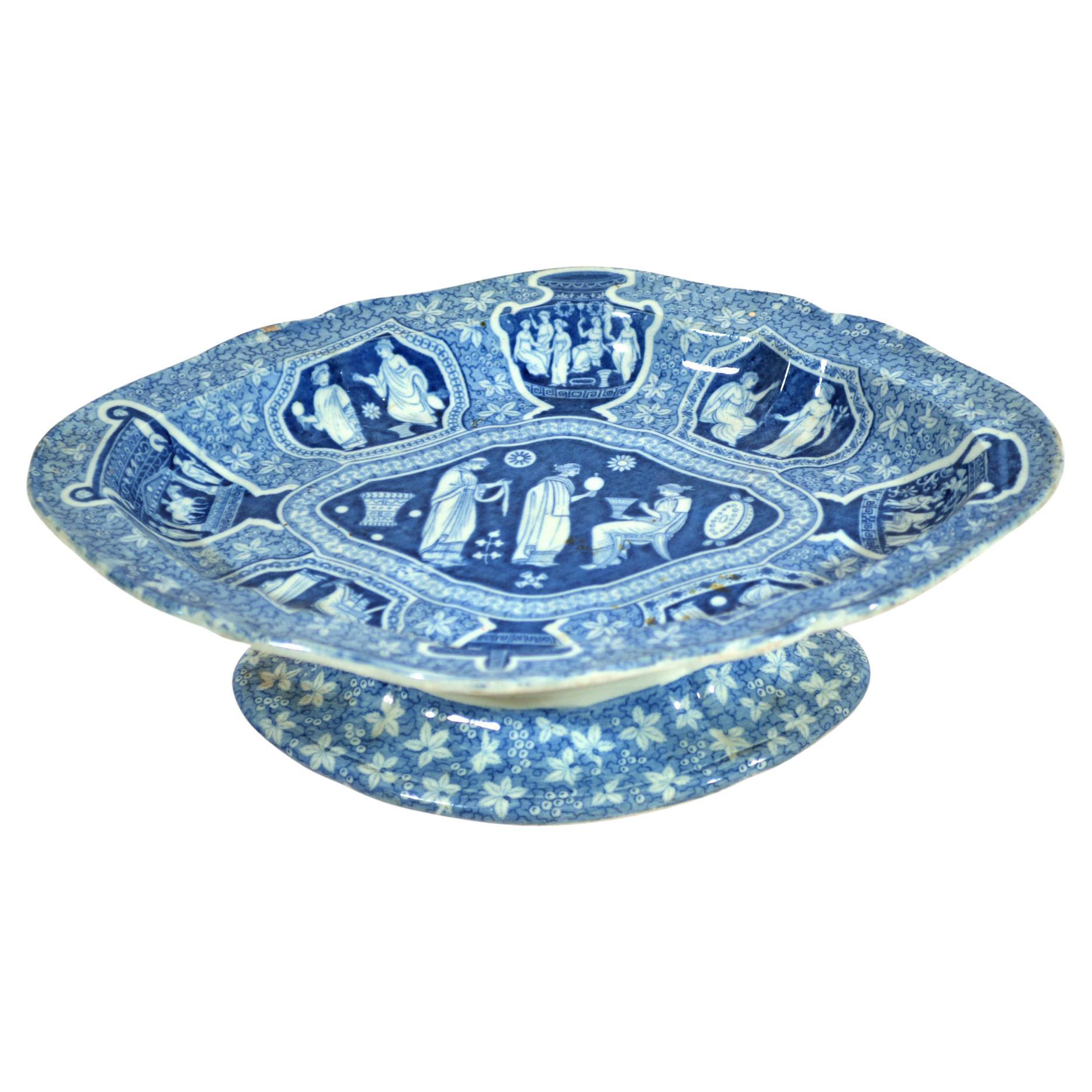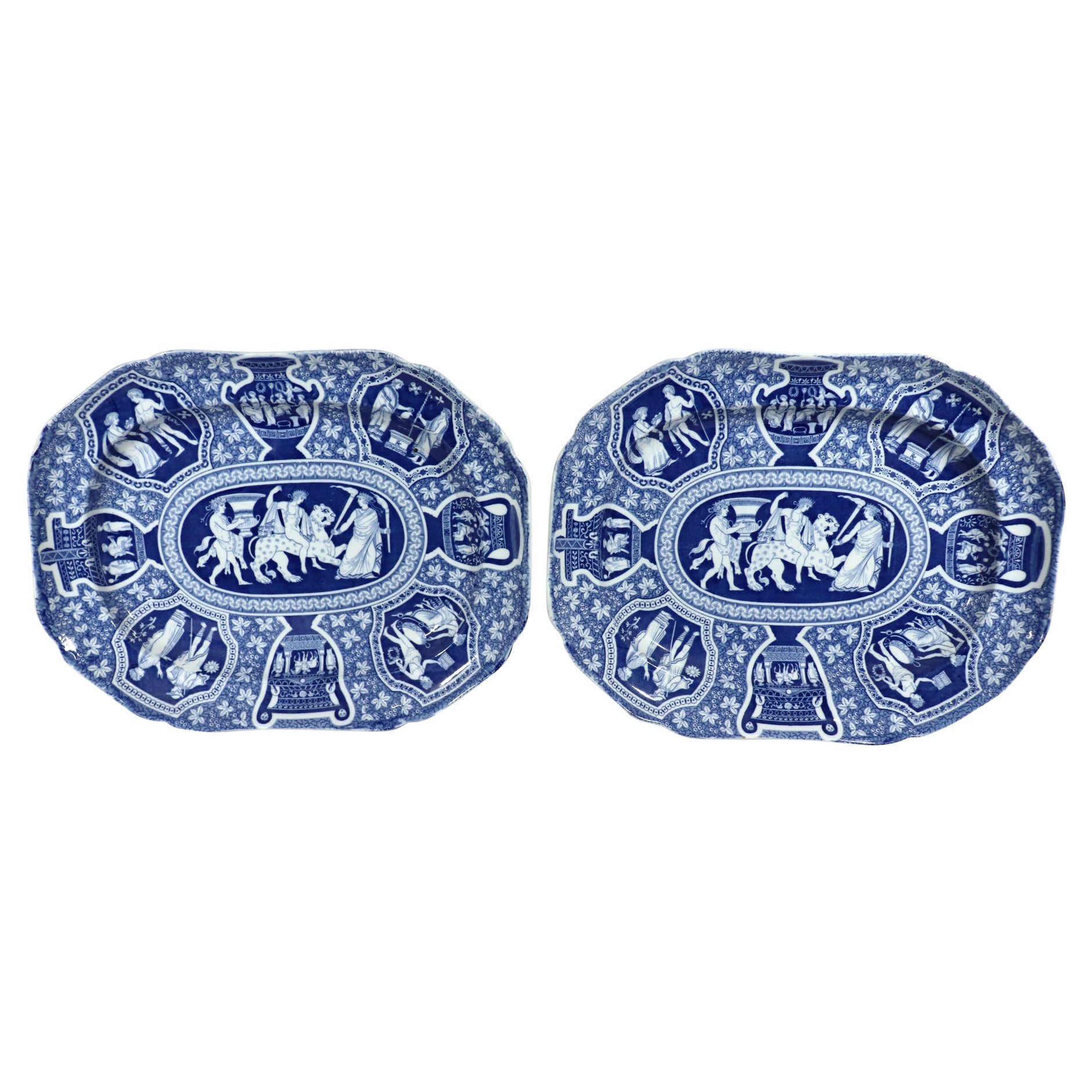Regency Spode Pottery Neo-Classical Greek Pattern Blue Dish
About the Item
- Creator:Spode (Manufacturer)
- Dimensions:Height: 1.5 in (3.81 cm)Width: 12.5 in (31.75 cm)Depth: 9.75 in (24.77 cm)
- Style:Neoclassical (Of the Period)
- Materials and Techniques:
- Place of Origin:
- Period:
- Date of Manufacture:1810-1825
- Condition:Wear consistent with age and use.
- Seller Location:Downingtown, PA
- Reference Number:
Spode
Spode is one of the oldest and most distinguished of the great pottery companies of Staffordshire, the time-honored home of English ceramics. The firm’s blue and white bone china transferware is a timeless classic. Spode dishes compose the sort of elegant dinner service that most of us envision on a traditional holiday table.
The company was established in 1770 in Stoke-on-Trent by Josiah Spode, a friend and neighbor of another estimable English ceramist, Josiah Wedgwood. Spode was particularly known for two technical achievements in the firm’s early decades. The first was to develop a standard formula for the making of bone china — a type of porcelain (made with a mixture of bone ash, minerals and clay) that is dazzlingly white and so strong it can be used to create very thin translucent plates and vessels. The other was to perfect the making of transferware. That process involves the transfer of pictorial images inked on tissue paper — such as the garden scenery in the famous Willow dish patterns — onto ceramics that are then sealed with a glaze. In 1833, following the sudden death of Josiah Spode III, business partner W.T. Copeland took over the company and changed its name. Collectors regard Copeland-marked pieces as Spode china. The Spode brand was revived in 1970.
From the 1820s onward, Spode enjoyed tremendous success both in Britain and elsewhere owing to the beauty and vitality of its decorative imagery. By some counts, Spode created more than 40,000 patterns in the 19th century. Many favorite Spode patterns — among them Blue Italian, India Tree, Greek and Woodland — date to the company’s early years. Spode’s most popular pattern, Christmas Tree, was introduced in 1938. Prices for Spode china vary widely, based on the size of the service, its condition and the pattern. An antique dinner service for 12 people or more, in good repair and complete with cups and serving dishes, will generally cost between $10,000 and $20,000. Such Spode services become heirlooms — a proud and timeless addition to a family’s table. And as you will see on these pages, Spode’s rich and varied wares offer a visual feast in and of themselves.
- ShippingRetrieving quote...Ships From: Downingtown, PA
- Return PolicyA return for this item may be initiated within 3 days of delivery.
- Spode Pottery Neo-Classical Greek Pattern Blue Deep DishBy SpodeLocated in Downingtown, PASpode pottery neo-classical Greek pattern blue deep dish, Bacchus Mounted on a Panther, Early-19th Century The Spode Greek pattern pottery shaped rectangular dish with cantered...Category
Antique Early 19th Century English Neoclassical Pottery
MaterialsPearlware, Pottery
- Spode Neo-Classical Greek Pattern Blue Oval Dessert DishesBy SpodeLocated in Downingtown, PASpode neo-classical Greek pattern blue oval dessert dishes, "A Domestic Ceremony", Early 19th century The Spode Greek pattern pottery dishes a...Category
Antique Early 19th Century English Neoclassical Pottery
MaterialsPearlware, Pottery
- Spode Pottery Neo-Classical Greek Pattern Blue Dessert DishBy SpodeLocated in Downingtown, PASpode Pottery neoclassical Greek Pattern Blue Dessert dish, circa 1810 The Spode pearlware pottery-shaped dessert Greek Pattern dish has a central pan...Category
Antique Early 19th Century English Georgian Platters and Serveware
MaterialsPearlware, Pottery
- Copeland & Garrett Pottery Neo-Classical Greek Pattern Large Blue DishBy Copeland & Garrett SpodeLocated in Downingtown, PACopeland & Garrett Pottery neo-classical Greek Pattern blue dish, Centaurs Battling Theseus, 1833-47 The Spode Greek pattern pottery, shaped r...Category
Antique Mid-19th Century English Neoclassical Platters and Serveware
MaterialsPearlware, Pottery
- Regency Spode Neo-Classical Greek Pattern Blue TazzaBy SpodeLocated in Downingtown, PASpode Neo-Classical Greek Pattern Tazza Early-19th century The Spode pottery underglaze blue Greek pattern has an oval shaped top with a central des...Category
Antique Early 19th Century English Regency Pottery
MaterialsPearlware, Pottery
- Spode Pottery Large Neoclassical Greek Pattern Blue Pair of DishesBy SpodeLocated in Downingtown, PASpode pottery neoclassical Greek pattern blue pair of dishes, Bacchus Mounted on a Panther, Early-19th century The Spode Greek pattern pottery sha...Category
Antique Early 19th Century English Neoclassical Platters and Serveware
MaterialsPearlware, Pottery
- Early Spode Red Greek Pattern TileBy Josiah Spode, SpodeLocated in Fort Lauderdale, FLA Neoclassical red transferware tile made by Spode 1806-1810, with the ‘Refreshments for Phliasian Horseman’ pattern. Sir William Hamilton’s Collection of Etruscan, Greek and Roman antiquities, first published in 1766 by Pierre d’Hancarville, was a landmark publication in English design. It intended to disseminate the Antique style through its engravings of Attic pottery. The catalog’s faithful reproductions of Classical vases led British potteries, including Spode, to adapt or even copy the ancient art for modern life. These Spode Greek pattern tiles reflect the major influence of Hamilton’s catalog on English Neoclassicism. The central scene was taken directly from the catalog. This tile can be dated to a narrow window of production in the Spode factory, 1806-1810. During that time, Spode used a technique known as the “Pluck and Dust” method to print in red transfer designs onto creamware. Using this method, source prints were transferred overglaze using tissue imprinted with a very faint rendition of the design outlined in sticky oil. The decorator applied the tissue to the object then carefully “plucked” or pulled it away, leaving the sticky oil design behind. Then, a finely-ground enamel color was “dusted” onto the surface, sticking to any areas that had the oil. A final firing at a low temperature in the enamel kiln made the pattern permanent. The Pluck and Dust technique improved upon bat-printing and enabled larger designers to be transferred. It was short-lived, however, as under-glaze transfer printing soon took over as the preferred method for producing transferwares. Dimensions: 5 in. x 5 in. x 1/4 in. Condition: Excellent. Slight chip to the upper left corner measuring approximately 0.9 cm. in length. Provenance: The Collection of Nancy and Andrew Ramage Jonathan Horne...Category
Antique Early 19th Century English Neoclassical Pottery
MaterialsEarthenware, Creamware
- Early 19th Century Spode Red Greek Pattern TileBy Spode, Josiah SpodeLocated in Fort Lauderdale, FLA Neoclassical red transferware tile made by Spode 1806-1810, with the ‘Zeus in His Chariot’ pattern. Sir William Hamilton’s Collection of Etruscan, Greek and Roman antiquities, first published in 1766 by Pierre d’Hancarville, was a landmark publication in English design. It intended to disseminate the Antique style through its engravings of Attic pottery. The catalog’s faithful reproductions of Classical vases led British potteries, including Spode, to adapt or even copy the ancient art for modern life. These Spode Greek pattern tiles reflect the major influence of Hamilton’s catalog on English Neoclassicism. The central scene was taken directly from the catalog. This tile can be dated to a narrow window of production in the Spode factory, 1806-1810. During that time, Spode used a technique known as the “Pluck and Dust” method to print in red transfer designs onto creamware. Using this method, source prints were transferred overglaze using tissue imprinted with a very faint rendition of the design outlined in sticky oil. The decorator applied the tissue to the object then carefully “plucked” or pulled it away, leaving the sticky oil design behind. Then, a finely-ground enamel color was “dusted” onto the surface, sticking to any areas that had the oil. A final firing at a low temperature in the enamel kiln made the pattern permanent. The Pluck and Dust technique improved upon bat-printing and enabled larger designers to be transferred. It was short-lived, however, as under-glaze transfer printing soon took over as the preferred method for producing transferwares. Dimensions: 5 in. x 5 in. x 1/4 in. Condition: Excellent. Provenance: The Collection of Nancy and Andrew Ramage Jonathan Horne...Category
Antique Early 19th Century English Neoclassical Pottery
MaterialsEarthenware, Creamware
- Large Spode Greek Pattern Platter Circa 1810By SpodeLocated in Ottawa, OntarioLarge Spode Greek Pattern Platter Circa 1810. 14 5/8" in. (37.2 cm) long. 11 3/8" in. (28.9 cm.) wide. Printed in blue underglaze on an indented earthenware platter. Central scene is showing Bacchus with entourage. He is riding on a panther symbolizing his conquest of India. The image is based on a print published in M.W. Tischbein, 1791 “Collection of Engravings...Category
Antique Early 19th Century English Greek Revival Platters and Serveware
MaterialsPorcelain
- Spode Stone China Dish Decorated with Pattern 2283By SpodeLocated in East Geelong, VICThis oval hand coloured and gilded Spode Stone China dish is decorated with an Imari pattern- pattern 2283. It could also be that this item is a stan...Category
Antique 1810s English Regency Platters and Serveware
MaterialsStoneware
- Early Spode Shaped DishBy SpodeLocated in High Point, NCEarly 19th century signed Spode handled serving dish with a wonderful shaped handle and scalloped edge. The pattern is of a lovely Asian village.Category
Antique 19th Century English Victorian Platters and Serveware
MaterialsPorcelain
- Dutch Rare Delft Faience Polychrome Lady in Landscape Pottery DishBy DelftLocated in Bishop's Stortford, HertfordshireA very Fine and rare early 18th century antique Dutch delft faience polychrome pottery dish of shallow rounded form hand painted with a period figure of a lady carrying a parasol, early 20th century. The large earthenware dish is hand painted with a central scene of a lady wearing a tall bonnet in a landscape with a building in the background painted in tones of red, puce, green and blue set within a yellow painted decorative border...Category
Antique Early 18th Century Dutch Dutch Colonial Pottery
MaterialsEarthenware
